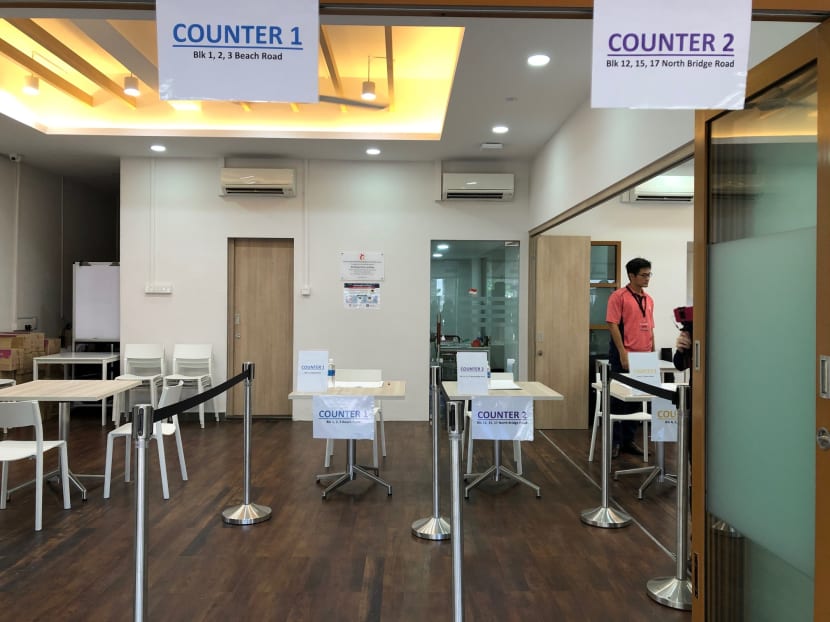Distribution of masks will start at 200 RC centres from Feb 1
SINGAPORE — About 200 Residents’ Committee (RC) centres spread across the island will be turned into surgical-mask distribution points from Saturday (Feb 1), Trade and Industry Minister Chan Chun Sing said.

A mask distribution point at the Kampong Glam Beach Road Residents’ Committee centre photographed on Friday (Jan 31).
SINGAPORE — About 200 Residents’ Committee (RC) centres spread across the island will be turned into surgical-mask distribution points from Saturday (Feb 1), Trade and Industry Minister Chan Chun Sing said.
Residents may begin to collect masks at these centres from 2pm to 10pm on Saturday, as the Government makes them available to all 1.37 million households amid a global outbreak of the Wuhan coronavirus.
Details about the locations of the 200 RC centres were not immediately available, but there will be collection points in towns such as Tampines, Punggol and Sembawang. Households can check where to collect their masks at https://maskgowhere.sg/
Each of the RC centres will serve assigned blocks. For instance, the Kampong Glam Beach Road RC centre will serve 14 blocks along Beach Road, North Bridge Road and Jalan Sultan.
Each household will receive a pack of four masks. In all, about 5.2 million masks will be handed out.
The masks will be distributed over a week from Saturday to next Sunday, and they will be rolled out progressively to the 89 community clubs (CCs) and 654 RC centres.
From Sunday, collection will be from 10am to 9pm.
Speaking to reporters on Friday at the Kampong Glam Beach Road RC centre, Mr Chan, who is also PA’s deputy chairman, said the 200 RC centres would receive the first batch of masks by Friday evening.
Crew from the Singapore Armed Forces will pack and deliver the masks.
Mr Chan said collection times would be staggered, mostly by housing blocks, to prevent queues forming.
About 2,500 to 3,000 units in every estate will be served every day. Even at the height of the distribution process, collection should take only several minutes, Mr Chan said.
Volunteers will deliver masks to the homes of those who are less mobile, he added.
Priority will be given to areas with a concentration of vulnerable residents, those living in rental blocks, and members of the Pioneer Generation.
Singaporeans may get more information about collection via RC notice boards, neighbourhood digital display panels and the social media platforms of their local communities.
The public may also dial 1800 333 9999 to seek answers about collection from Saturday. The hotline will operate from 2pm to 10pm on Saturday. From Feb 2 to Feb 9, it will take calls from 9am to 9pm.
Residents in private estates will be notified about collection by their Neighbourhood Committees. Information will also be broadcast to those living in these estates, Mr Chan said.
For private estates without an RC, mask distributors will set up collection booths at convenient locations.
Mr Chan cited the Watten estate in Bukit Timah as an example. “There are some places that the residents generally gather at the parks or the pavilions, and that’s where we’ll set up the collection centre for the convenience of the residents.”
NO NEED TO RUSH
Mr Chan urged families not to rush because collection would take just a few minutes.
“We will have enough capacity for all the households in Singapore,” he said, adding that the Government had carried out similar exercises during the haze crisis in 2015 and the Severe Acute Respiratory Syndrome outbreak of 2003.
WHY COULDN’T MASKS BE MAILED TO HOMES?
On Friday, Mr Chan was asked about public feedback on why the masks could not be sent to families by post.
Some Singaporeans voiced concerns that gathering large groups at the mask-collection points would raise the odds of the virus spreading.
Thus far, the virus has not spread within the community here. The 13 patients in Singapore who have contracted the virus are from China’s Hubei province, the epicentre of the outbreak.
Mr Chan said that based on the Government’s experience, putting masks in mailboxes would lead to a “high wastage rate”.
Some households do not need the masks, but would still be sent a pack, he said.
People are also more assured that the masks are clean and safe if they receive them by hand, Mr Chan added.
The Government, he said, also wanted to disseminate the masks in person, so that the distributors can take the opportunity to answer questions the public may have.
“Many of the elderly (people) especially will need some assurance on how to use it, when to use it,” he said.
“It’s also a chance for the volunteers to reach out to their neighbours to help explain what’s the situation like, calm their fears, and at the same time, help them to address any concerns.”








